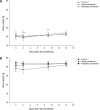Severity classification of repeated isoflurane anesthesia in C57BL/6JRj mice-Assessing the degree of distress
- PMID: 28617851
- PMCID: PMC5472303
- DOI: 10.1371/journal.pone.0179588
Severity classification of repeated isoflurane anesthesia in C57BL/6JRj mice-Assessing the degree of distress
Abstract
According to the EU Directive 2010/63, the severity of a procedure has to be classified as mild, moderate or severe. General anesthesia is thought to be mild, but the Directive does not differentiate between single and repeated anesthesia. Therefore, we investigated the impact of repeated administration of isoflurane, the most commonly used inhalation anesthetic, on the well-being of adult C57BL/6JRj mice, in comparison to single administrations and to untreated animals, when applied six times for 45 min at an interval of 3-4 days. For the animals anesthetized, excitations, phases of anesthesia, and vital parameters were monitored. Well-being after anesthesia was assessed using a behavioral test battery including luxury behavior like burrowing and nest building behavior, the Mouse Grimace Scale (MGS), the free exploratory paradigm for anxiety-related behavior, home cage activity and the rotarod test for activity, as well as food intake and body weight. Additionally, hair corticosterone and fecal corticosterone metabolites were measured. Our results show that nest building behavior, home cage activity, body weight, and corticosterone concentrations were not influenced by anesthesia, whereas changes in burrowing behavior, the MGS, food intake, and the free exploratory behavior indicated that the well-being of the mice was more affected by repeated than single isoflurane anesthesia. This effect depended on the sex of the animals, with female mice being more susceptible than male mice. However, repeated isoflurane anesthesia caused only short-term mild distress and impairment of well-being, mainly in the immediate postanesthetic period. Well-being stabilized at 8 days after the last anesthesia, at the latest. Therefore, we conclude that when using our anesthesia protocol, the severity of both single and repeated isoflurane anesthesia in C57BL/6JRj mice can be classified as mild. However, within the mild severity category, repeated isoflurane anesthesia ranks higher than single isoflurane anesthesia. Additionally, our results imply that male and female mice can differently perceive the severity of a procedure.
Conflict of interest statement
Figures





Similar articles
-
Impact of repeated anesthesia with ketamine and xylazine on the well-being of C57BL/6JRj mice.PLoS One. 2018 Sep 19;13(9):e0203559. doi: 10.1371/journal.pone.0203559. eCollection 2018. PLoS One. 2018. PMID: 30231081 Free PMC article.
-
Effect of Repeated Exposure to Isoflurane on Nest Building and Burrowing in Mice.J Am Assoc Lab Anim Sci. 2020 Jan 1;59(1):30-36. doi: 10.30802/AALAS-JAALAS-19-000027. Epub 2020 Jan 2. J Am Assoc Lab Anim Sci. 2020. PMID: 31896393 Free PMC article.
-
Burrowing and nest building activity in mice after exposure to grid floor, isoflurane or ip injections.Physiol Behav. 2019 Jul 1;206:59-66. doi: 10.1016/j.physbeh.2019.02.022. Epub 2019 Feb 18. Physiol Behav. 2019. PMID: 30790576
-
Burrowing and nest building behavior as indicators of well-being in mice.J Neurosci Methods. 2014 Aug 30;234:139-46. doi: 10.1016/j.jneumeth.2014.02.001. Epub 2014 Feb 10. J Neurosci Methods. 2014. PMID: 24525328 Review.
-
Grimace scale, burrowing, and nest building for the assessment of post-surgical pain in mice and rats-A systematic review.Front Vet Sci. 2022 Oct 6;9:930005. doi: 10.3389/fvets.2022.930005. eCollection 2022. Front Vet Sci. 2022. PMID: 36277074 Free PMC article.
Cited by
-
MicroRNAs as systemic biomarkers to assess distress in animal models for gastrointestinal diseases.Sci Rep. 2020 Oct 9;10(1):16931. doi: 10.1038/s41598-020-73972-7. Sci Rep. 2020. PMID: 33037288 Free PMC article.
-
A New Tool for Quantifying Mouse Facial Expressions.eNeuro. 2023 Feb 23;10(2):ENEURO.0349-22.2022. doi: 10.1523/ENEURO.0349-22.2022. Print 2023 Feb. eNeuro. 2023. PMID: 36759187 Free PMC article.
-
Automated Home-Cage Monitoring During Acute Experimental Colitis in Mice.Front Neurosci. 2021 Oct 22;15:760606. doi: 10.3389/fnins.2021.760606. eCollection 2021. Front Neurosci. 2021. PMID: 34744621 Free PMC article.
-
Bone healing response in cyclically loaded implants: Comparing zero, one, and two loading sessions per day.J Mech Behav Biomed Mater. 2018 Sep;85:152-161. doi: 10.1016/j.jmbbm.2018.05.044. Epub 2018 May 31. J Mech Behav Biomed Mater. 2018. PMID: 29894930 Free PMC article.
-
Systematic Assessment of Well-Being in Mice for Procedures Using General Anesthesia.J Vis Exp. 2018 Mar 20;(133):57046. doi: 10.3791/57046. J Vis Exp. 2018. PMID: 29630060 Free PMC article.
References
-
- Richardson CA, Flecknell PA. Anaesthesia and post-operative analgesia following experimental surgery in laboratory rodents: are we making progress? ATLA. 2005;33:119–27. - PubMed
-
- Stokes EL, Flecknell PA, Richardson CA. Reported analgesic and anaesthetic administration to rodents undergoing experimental surgical procedures. Lab Anim. 2009;43:149–54. doi: 10.1258/la.2008.008020 - DOI - PubMed
-
- Flecknell P. Laboratory Animal Anaesthesia 4th ed. Oxford: Academic Press; 2016.
-
- Ding F, Zheng L, Liu M, Chen R, Leung LS, Luo T. Ciproxifan, an H3 receptor antagonist, improves short-term recognition memory impaired by isoflurane anesthesia. J Anesth. 2016;30:684–90. doi: 10.1007/s00540-016-2189-y - DOI - PubMed
-
- Yonezaki K, Uchimoto K, Miyazaki T, Asakura A, Kobayashi A, Takase K, et al. Postanesthetic effects of isoflurane on behavioral phenotypes of adult male C57BL/6J mice. PloS One. 2015;10(3):e0122118 doi: 10.1371/journal.pone.0122118 - DOI - PMC - PubMed
MeSH terms
Substances
LinkOut - more resources
Full Text Sources
Other Literature Sources
Medical

